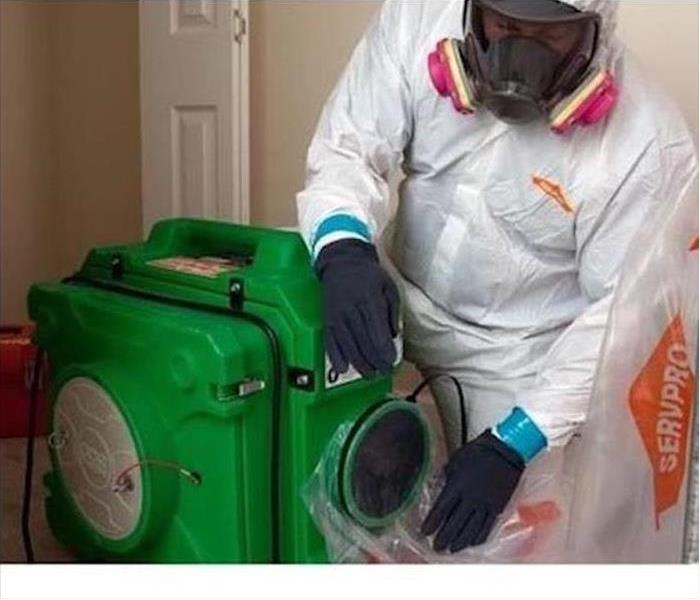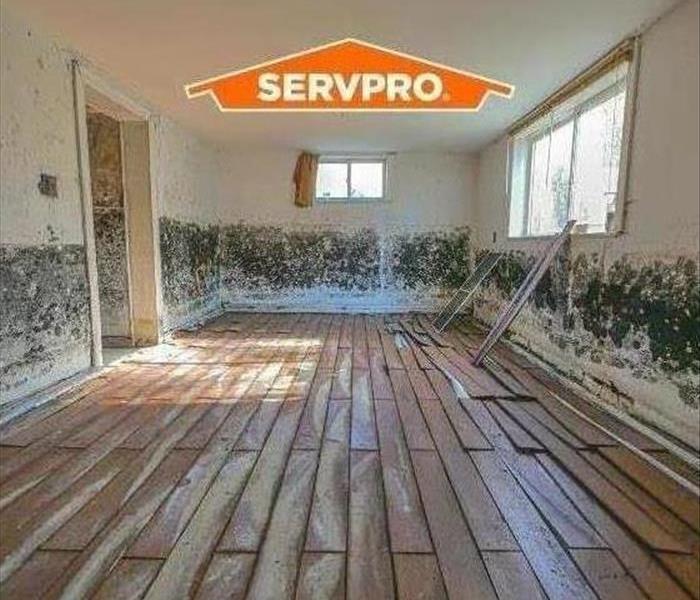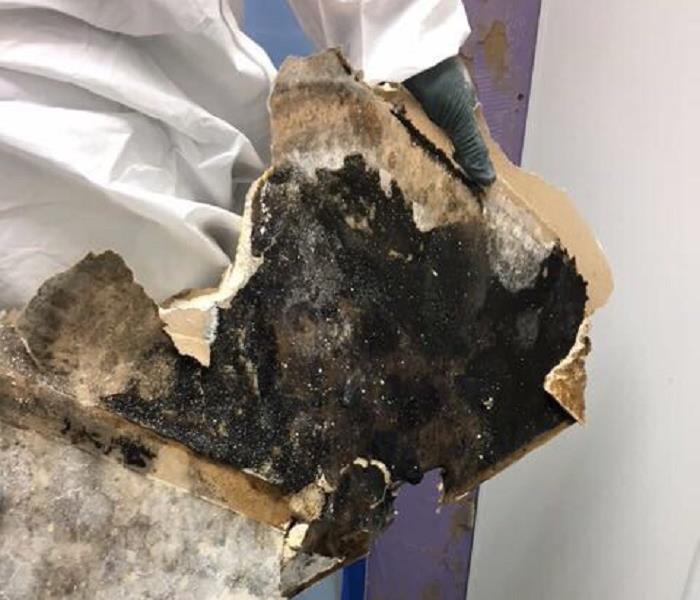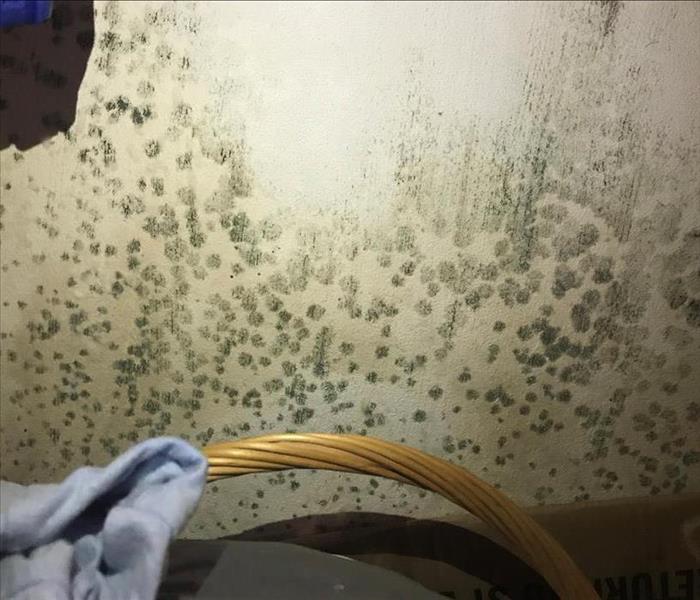Defeating Mold Damage: Expert Strategies for a Mold-Free Home | SERVPRO of Fenton/South Ballwin
9/26/2023 (Permalink)
 SERVPRO of Fenton/South Ballwin is your trusted choice for mold removal and remediation. Call us today at (636) 527-5990
SERVPRO of Fenton/South Ballwin is your trusted choice for mold removal and remediation. Call us today at (636) 527-5990
If you’ve ever experienced issues with mold, you know that it’s more than just an unsightly nuisance.
Mold can silently wreak havoc on your health and property. In this extensive guide, we will delve deep into the dangers of mold, how to detect its presence, and the indispensable role of professional mold remediation services. Whether you're dealing with mold removal, mold remediation, or the costs involved, this comprehensive resource will equip you with vital knowledge to protect your Fenton or South Ballwin, Missouri property.
Understanding Mold
Mold, a type of fungus, serves a vital role in nature by breaking down organic matter. However, when it infiltrates our indoor spaces, it can cause a multitude of issues. Let's explore the key aspects of mold:
• Health Risks: Exposure to mold can lead to a range of health problems. Mold spores are allergens that can trigger asthma, allergies, respiratory issues, and skin irritations.
• Black Mold (Stachybotrys chartarum): Often dubbed "toxic black mold," this species is particularly notorious for its mycotoxins, which can lead to severe health problems when inhaled or touched.
• Property Damage:P Mold thrives on organic materials like wood, drywall, and insulation, causing structural damage and costly repairs.
• Airborne Allergens: Mold releases allergenic proteins that can initiate allergies, even in individuals who haven't experienced them before.
• Mold Odor: Mold produces a distinct, musty odor that permeates the environment, making your indoor space uncomfortable and unwelcoming.
Identifying Mold Damage
Early detection is crucial for effective mold remediation. In many cases, it will be necessary to call a professional mold remediation company for mold testing. Mold often grows in concealed, inaccessible areas, rendering it invisible without professional help. Here are some telltale signs of mold damage:
• Visible Mold Growth: The most apparent indication is the presence of visible mold. It can manifest as fuzzy, discolored patches on walls, ceilings, or other surfaces.
• Musty Odor: An enduring, musty smell is a strong indicator of mold growth, even if you can't see it. This scent is a result of the volatile organic compounds (VOCs) emitted by mold.
• Water Damage History: Properties with a history of water damage, flooding, or leaks are at higher risk for mold growth. Mold thrives in moist environments.
• Health Symptoms: If occupants experience unexplained health symptoms like coughing, sneezing, congestion, or skin irritation that improve when leaving the property, mold may be the culprit.
• Peeling Paint or Wallpaper: Mold can cause paint or wallpaper to peel or bubble as it grows beneath these surfaces.
The Mold Remediation Process
Mold remediation is a complex, regulated process aimed at identifying, containing, and eliminating mold to ensure the safety and health of occupants. Here's an overview of the standard mold remediation process:
Mold Inspection and Assessment
Before embarking on the remediation journey, a certified mold inspector evaluates the extent of the mold damage. They identify the type of mold, its location, and the underlying moisture source that fueled its growth.
Containment
Effective containment is vital to prevent mold spores from migrating to uncontaminated areas. Professionals utilize plastic sheeting and negative air pressure machines to isolate the affected area.
Mold Removal
The next stage involves the physical mold removal. Depending on the infestation's scale, this may entail removing and disposing of materials like drywall, insulation, or carpeting. Professionals wear personal protective equipment (PPE) and adhere to stringent safety protocols throughout this phase.
Mold Cleaning and Sanitization
All surfaces within the containment area undergo thorough cleaning and sanitization, utilizing specialized equipment and antimicrobial agents to eliminate any lingering mold spores.
Drying and Dehumidification
To prevent future mold growth, experts employ industrial-grade dehumidifiers and air movers to fully dry the affected space. Addressing the moisture source is pivotal in mold prevention.
Post-Remediation Testing
After remediation, a certified mold testing company may perform post-remediation testing to confirm the successful resolution of the mold issue and ensure safe indoor air quality.
Assessing Mold Remediation Costs
The cost of mold remediation can vary considerably based on factors such as the extent of the infestation, the type of mold, and its location within the property. Several factors may influence mold remediation costs:
• Infestation Size: Larger mold infestations typically necessitate more extensive remediation efforts, leading to higher costs.
• Location Complexity: Mold in confined or challenging-to-reach areas may require additional labor and equipment, impacting the overall cost.
• Mold Type: Hazardous molds, including toxic black mold, may necessitate more elaborate safety measures, driving up costs.
• Structural Damage: Mold that has caused structural deterioration may entail expensive repairs, such as drywall replacement or subfloor restoration.
• Insurance Coverage: Depending on your insurance policy, a portion or the entirety of the remediation costs may be covered, reducing your financial burden.
It's crucial to remember that while mold remediation costs are a concern, the health and safety of occupants should take precedence. Cutting corners during mold remediation can result in incomplete removal and recurrent mold problems.
A Mold Remediation Company You Can Trust: SERVPRO of Fenton/South Ballwin
When seeking mold remediation services, it's essential to choose a reputable and experienced mold removal company. Here are some essential considerations for selecting the right professionals:
• Certifications: Seek out companies and technicians certified by renowned organizations such as the Institute of Inspection, Cleaning and Restoration Certification (IICRC) or the National Association of Mold Professionals (NAMP).
• References: Request references or peruse online reviews on sites such as Google or Yelp to gauge the company's reputation and customer satisfaction.
• Experience: Opt for a company with extensive experience in mold remediation. Their knowledge and expertise will be indispensable in handling your specific situation.
• Transparency: The chosen company should provide a detailed scope of work, including a written estimate and a clear explanation of the
In your quest for mold removal and remediation services, consider the mold remediation experts at SERVPRO of Fenton/South Ballwlin, experienced professionals dedicated to ensuring your safety and restoring your peace of mind.
Preventing Future Mold Infestations
After successfully remedying mold, it's imperative to implement preventive measures to stave off future mold issues. Here are some strategies to maintain a mold-free environment:
• Moisture Control: Identify and rectify moisture sources, such as leaks, plumbing issues, or inadequate ventilation. Keeping indoor humidity levels below 60% is a potent preventive measure.
• Routine Maintenance: Perform regular inspections and maintenance to spot and address potential problem areas early, before they become breeding grounds for mold.
• Proper Ventilation: Ensure ample ventilation in moisture-prone zones like bathrooms, kitchens, and basements. Consider using exhaust fans and dehumidifiers if necessary.
• Effective Drainage: Channel rainwater away from your property by maintaining gutters, downspouts, and proper grading.
• Timely Repairs: Swiftly attend to water damage issues. Do not delay in fixing leaks, roof damage, or plumbing problems that can spawn mold growth.
Conclusion
Mold damage is a formidable adversary that poses health risks, property damage, and persistence without proper management. Mold removal and remediation are tasks best entrusted to certified professionals who possess the expertise, equipment, and experience to ensure thorough and safe mold cleanup. By understanding the perils of mold, recognizing its presence, and taking proactive measures, you can safeguard your property and the well-being of your loved ones. Always remember, when it comes to mold, prevention is paramount, but prompt and effective remediation is your first line of defense.
SERVPRO of Fenton/South Ballwin is here to help with your mold remediation services needs. We have 24/7 emergency services and are always available for mold testing and mold estimates. Call us today at (636) 527-5990.
Should You Get Your Fenton/South Ballwin Home Tested For Mold?
5/25/2023 (Permalink)
 SERVPRO of Fenton/South Ballwin is here to help with mold remediation
SERVPRO of Fenton/South Ballwin is here to help with mold remediation
SERVPRO of Fenton/South Ballwin is here to help with mold remediation.
When is time to get a sample for mold? If visible mold growth is present, sampling is unnecessary.
Surface sampling may be useful to determine if an area has been adequately cleaned or remediated. Sampling for mold should be conducted by professionals who have specific experience in designing mold sampling protocols, sampling methods and interpreting results.
Sample analysis should follow analytical methods recommended by the American Industrial Hygiene Association (AIHA), the American Conference of Governmental Industrial Hygienists (ACGIH), or other professional organizations.
Are there federal regulations or standards regarding mold testing?
Standards or Threshold Limit Values (TLVs) for airborne concentrations of mold, or mold spores, have not been set. Currently, there are no EPA regulations or standards for airborne mold contaminants.
Understanding Mold
When water intrudes into your property, mold growth can start in as little as 48 hours. Consider the following mold facts:
- Mold is present almost everywhere, indoors and outdoors.
- Mold spores are microscopic, float along in the air, and may enter your home through windows, doors, or AC/heating systems or even hitch a ride indoors on your clothing or a pet.
- Mold spores thrive on moisture. Mold spores can quickly grow into colonies when exposed to water. These colonies may produce allergens and irritants.
- Before mold remediation can begin, any sources of water or moisture must be addressed. Otherwise, the mold may return.
- Mold often produces a strong, musty odor, and that odor can lead you to possible mold problem areas.
- Even higher-than-normal indoor humidity can support mold growth. Keep indoor humidity below 45 percent.
The Mold Remediation Process
Every mold damage scenario is different and requires a unique solution, but the general mold remediation process stays the same. Learn more about our mold remediation process.
- Emergency Contact - (636) 484-9460
- Inspection and Mold Damage Assessment
- Mold Containment
- Air Filtration
- Removing Mold and Mold-Infested Materials
- Cleaning Contents and Belongings
What is Microbial Contamination?
6/3/2019 (Permalink)
What is Microbial Contamination? Where does mold come from? Is microbial contamination a health concern issue? How do you properly get rid of a microbial contamination?
Microbial contamination refers to a variety of microorganisms, including mold, bacteria, viruses and protozoa; and fungi, which includes molds, yeasts, and their by products and toxins. All of these can affect the health of a building and its occupants.
As a starting point the proper job sequencing for a typical microbial-remediation project includes but it not limited to: identifying and stopping the source of moisture; setting up containment; establishing negative air; removing contaminated building materials; cleaning surfaces; drying the affected areas; conducting a post remediation evaluation.
Mold spores are a major concern for our project managers. Because of their very small size, mold spores can be anywhere there is air, including under carpet, inside wall cavities, under kitchen cabinets, virtually everywhere. Molds are usually not a problem unless mold spores land on a damp spot and begin growing. They digest whatever organic material they grow on in order to survive. Some molds grow on wood, paper, carpet, foods and insulation, while other molds feast on the everyday dust and dirt that gather in the moist regions of a building. Generally mold spores are hydrophobic. This means that spores do not like water itself. While mold spores need water to colonize (germinate and grow), they like wet organic substances, not a puddle of standing water.
Never use a DIY mold test, Heres why!
8/27/2018 (Permalink)
If you look on the internet, there are scores of DIY mold test kits. Before you invest in one of these kits, here are things you ought to know about mold:
- Mold is everywhere and every single house has some form of “mold.”
- Most self-test mold kits only tell you if your home has mold, but often provides false negatives and positives. It also does not tell you what kind of mold or how to kill it.
A true mold test can only be conducted by a Professional Environmental testing company; they determine the type of mold, the source of the moisture, and how to kill the mold at the core. They create a protocol, which can be read by an IICRC professional (like us!). It’s best to use a testing company that does not do cleaning themselves because their assessment will be unbiased.
- Mold is more often hidden, sometimes under the floor or in the walls, or in your air ducts
Where the mold is located, often dictates where the moisture is affecting the building
- Untreated water damage may result in mold growth within 24-48 hours of the event
Wood, insulation, fiberglass, carpet and other organic substances become a thriving environment for mold once there is moisture present for more than 24 hours. After a week, it is almost guaranteed.
Free estimates or removing mold yourself cost homeowners more in the long run
Be wary of companies who advertise free mold testing. Free mold tests are often offered by people who are uncertified or inexperienced and if they do the mold testing themselves, they are using these kits mentioned above. Unless they are a certified Environmental Hygienist and have a PhD in microbiology, they do not have the knowledge or resources to truly diagnose the mold condition in your home.
- The source of the mold is never addressed, so the problem is reoccurring.
- They use the “self-test” kits mentioned above instead of environmental testing with diagnostics
- Remove only topical mold instead of killing it at the source
- They often remove more walls and floors than needed which increases the price to rebuild.
- They do not remove enough, or don’t use the right materials which brings the mold back.
This means you have to pay to have it removed again, and have more sanitation and demolition performed, which increases the price to rebuild and replace tremendously.
What you should do instead
Having mold can be scary, especially if anyone in your home is prone to getting sick (people with asthma, low immune systems, allergies, babies and the elderly). We recommend the following course of action if you need to have mold removed from your home.
- Measure the area affected and check for moisture.
- Call your insurance company, ask:
- If you are covered for mold
- What is your deductible
- What is your coverage
- Ask for a company that they approve of for mold mitigation (Chances are, it’s us.)
If your insurance company says you can use anyone – or if you are not going through insurance then look for someone who is certified in
- IICRC, Water Restoration Technician
- IICRC, Mold restoration
- IICRC, Applied Structural Drying
- Now that you’re armed with knowledge, it’s time to start making some calls.
Now that you know your coverage, how much visible mold there is in your home, and whom your insurance company approves as mold remediation specialists. It’s time to start making some calls.
The four W's of Mold
6/6/2018 (Permalink)
Protecting your home from the ravages of mold can be a daunting task if you don't know what to look for or don't know you have it. However, it's a process that every homeowner should consider in order to protect the structural integrity of their home as well as the health and wellness of their family.
The Four W's of Mold...
Who...
The process of determining if you have mold, and if so, what type begins with 5 questions that cover a number of considerations. It's a given that mold only grows in damp conditions. As a result, you must ask yourself if you or a neighbor has a water leak? Mold only takes a few days to form in moist situations. Even if you don't have a leak, your neighbor's leak could become a true bone of contention for you if you live in an apartment or duplex.
What Where and When...
Obviously, if you can visibly see mold you know you have a problem that needs resolving. Determining what type of mold you have becomes the obvious next step. Additionally, if you have water that pools against the exterior of your house when it rains, the moisture will affect not only exterior walls but the interior walls as well. It's just a question of "when."
Other Indicators...
In addition to visibly seeing mold, a musty moldy smell is a good indication that your dwelling has a mold issue. If the atmosphere in your home is humid, and your windows sweat revealing condensation, these are conditions that are ripe for developing a problem with mold if you don't already have one. Flair ups with allergies and illness in your pets are also strong indicators of a mold problem. Mold is a serious issue that can impact not only the infrastructure of your house but the health of you and your family members. Even if you plan on moving it's a good idea to have your new home tested for the presence of mold as a safety measure.
Having your home tested for mold is a good investment to protect the health and the integrity of both your family and your homes structure. After all, an ounce of prevention is always worth a ton of cure.Our crews here at SERVPRO Fenton and South Ballwin have all the necessary equipment to treat and make sure that everything is taken care of, "Like it never even happened." Give us a call at 636-527-5990!
 SERVPRO of Fenton/South Ballwin is your trusted choice for mold removal and remediation. Call us today at (636) 527-5990
SERVPRO of Fenton/South Ballwin is your trusted choice for mold removal and remediation. Call us today at (636) 527-5990




 24/7 Emergency Service
24/7 Emergency Service

